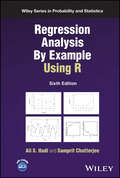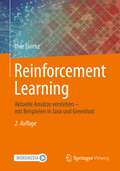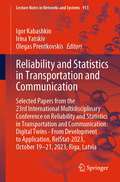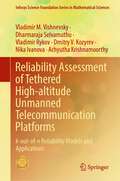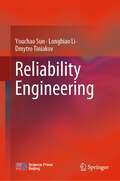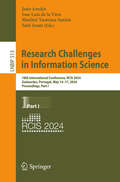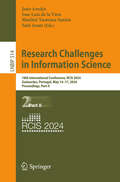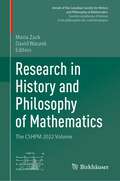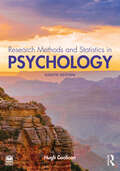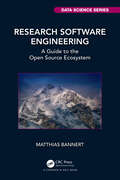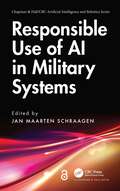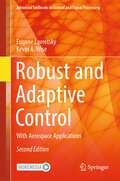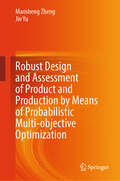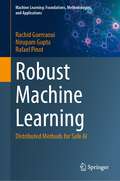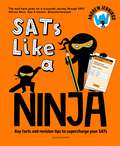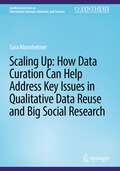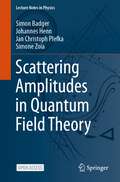- Table View
- List View
Regression Analysis By Example Using R (Wiley Series in Probability and Statistics)
by Ali S. Hadi Samprit ChatterjeeRegression Analysis By Example Using R A STRAIGHTFORWARD AND CONCISE DISCUSSION OF THE ESSENTIALS OF REGRESSION ANALYSIS In the newly revised sixth edition of Regression Analysis By Example Using R, distinguished statistician Dr Ali S. Hadi delivers an expanded and thoroughly updated discussion of exploratory data analysis using regression analysis in R. The book provides in-depth treatments of regression diagnostics, transformation, multicollinearity, logistic regression, and robust regression. The author clearly demonstrates effective methods of regression analysis with examples that contain the types of data irregularities commonly encountered in the real world. This newest edition also offers a brand-new, easy to read chapter on the freely available statistical software package R. Readers will also find: Reorganized, expanded, and upgraded exercises at the end of each chapter with an emphasis on data analysis Updated data sets and examples throughout the book Complimentary access to a companion website that provides data sets in xlsx, csv, and txt format Perfect for upper-level undergraduate or beginning graduate students in statistics, mathematics, biostatistics, and computer science programs, Regression Analysis By Example Using R will also benefit readers who need a reference for quick updates on regression methods and applications.
Reinforcement Learning: Aktuelle Ansätze verstehen – mit Beispielen in Java und Greenfoot
by Uwe LorenzIn uralten Spielen wie Schach oder Go können sich die brillantesten Spieler verbessern, indem sie die von einer Maschine produzierten Strategien studieren. Robotische Systeme üben ihre Bewegungen selbst. In Arcade Games erreichen lernfähige Agenten innerhalb weniger Stunden übermenschliches Niveau. Wie funktionieren diese spektakulären Algorithmen des bestärkenden Lernens? Mit gut verständlichen Erklärungen und übersichtlichen Beispielen in Java und Greenfoot können Sie sich die Prinzipien des bestärkenden Lernens aneignen und in eigenen intelligenten Agenten anwenden. Greenfoot (M.Kölling, King’s College London) und das Hamster-Modell (D.Bohles, Universität Oldenburg) sind einfache, aber auch mächtige didaktische Werkzeuge, die entwickelt wurden, um Grundkonzepte der Programmierung zu vermitteln. Wir werden Figuren wie den Java-Hamster zu lernfähigen Agenten machen, die eigenständig ihre Umgebung erkunden. Die zweite Auflage enthält neue Themen wie "Genetische Algorithmen" und "Künstliche Neugier" sowie Korrekturen und Überarbeitungen.
Reliability and Statistics in Transportation and Communication: Selected Papers from the 23rd International Multidisciplinary Conference on Reliability and Statistics in Transportation and Communication: Digital Twins - From Development to Application, RelStat-2023, October 19-21, 2023, Riga, Latvia (Lecture Notes in Networks and Systems #913)
by Igor Kabashkin Irina Yatskiv Olegas PrentkovskisThis book reports on cutting-edge theories and methods for analyzing complex systems, such as transportation and communication networks and discusses multi-disciplinary approaches to dependability problems encountered when dealing with complex systems in practice. The book presents the most relevant findings discussed at the 23rd International Multidisciplinary Conference on Reliability and Statistics in Transportation and Communication (RelStat 2023), which took place as a hybrid event on October 19 – 21, 2023, in/from Riga, Latvia. It spans a broad spectrum of advanced theories and methods, giving a special emphasis to the digitalization of transport systems, as well as smart, artificial intelligence, and digital twins applications.
Reliability Assessment of Tethered High-altitude Unmanned Telecommunication Platforms: k-out-of-n Reliability Models and Applications (Infosys Science Foundation Series)
by Vladimir M. Vishnevsky Dharmaraja Selvamuthu Vladimir Rykov Dmitry V. Kozyrev Nika Ivanova Achyutha KrishnamoorthyThis book provides a systematic presentation of the major results in the field of the theory of k-out-of-n systems obtained in recent years and their applications for the reliability assessment of high-altitude unmanned platforms. Mathematical models, methods, and algorithms, presented in the book, will make a significant contribution to the development of reliability theory and the theoretical foundations of unmanned UAV-based aerial communications networks in the framework of the concept of creating the 5G and beyond networks. The book gives a description of new mathematical methods and approaches (based on decomposable semi-regenerative processes, simulation and machine learning methods, and inventory models) to the study of the complex k-out-of-n systems, which makes it possible to carry out numerical calculations of reliability indicators. Organized into five chapters, each chapter begins with a summary of the main definitions andresults contained in the chapter. The content of this book is based on the original results developed by the authors, many of which appear for the first time in book form.
Reliability Engineering
by Youchao Sun Longbiao Li Dmytro TiniakovThis textbook covers the fundamentals of reliability theory and its application for engineering processes, especially for aircraft units and systems. Reliability basis was explained for the best understanding of reliability analysis application for engineering systems in aviation industry. Several approaches for the reliability analysis and their application with examples are presented. It also introduces main trends in the modern reliability theory development.This book will be interested for university students and early-career engineers of aviation industry majors.
Reliability Engineering: Data analytics, modeling, risk prediction
by Stefan BrackeThis textbook teaches methods of data analytics for technical reliability analyses and risk prognosis on the basis of probabilistics, statistics and modelling. The methods of Reliability Engineering are applied in the elementary phases of the product emergence process (concept and series development, production) as well as during the field use of technical products. This book contains a detailed outline of the basics of statistics, graphical visualisation and calculation methods. Numerous case studies are discussed, representing typical tasks of the engineer in reliability analysis during development/production as well as during the assessment of field damages. The target groups are thus both engineering students and practitioning engineers who deal with technical reliability in the context of the development and manufacturing of complex technical products as well as field data analyses. The presentation of the methods and procedures of Reliability Engineering follows the guideline "theory-guided - practice-oriented", so that this book can be used both as a reference work and as a textbook.
Rescuing Econometrics: From the Probability Approach to Probably Approximately Correct Learning (Routledge INEM Advances in Economic Methodology)
by Duo QinHaavelmo’s 1944 monograph, The Probability Approach in Econometrics, is widely acclaimed as the manifesto of econometrics. This book challenges Haavelmo’s probability approach, shows how its use is delivering defective and inefficient results, and argues for a paradigm shift in econometrics towards a full embrace of machine learning, with its attendant benefits. Machine learning has only come into existence over recent decades, whereas the universally accepted and current form of econometrics has developed over the past century. A comparison between the two is, however, striking. The practical achievements of machine learning significantly outshine those of econometrics, confirming the presence of widespread inefficiencies in current econometric research. The relative efficiency of machine learning is based on its theoretical foundation, and particularly on the notion of Probably Approximately Correct (PAC) learning. Careful examination reveals that PAC learning theory delivers the goals of applied economic modelling research far better than Haavelmo’s probability approach. Econometrics should therefore renounce its outdated foundation, and rebuild itself upon PAC learning theory so as to unleash its pent-up research potential. The book is catered for applied economists, econometricians, economists specialising in the history and methodology of economics, advanced students, philosophers of social sciences.
Rescuing Econometrics: From the Probability Approach to Probably Approximately Correct Learning (Routledge INEM Advances in Economic Methodology)
by Duo QinHaavelmo’s 1944 monograph, The Probability Approach in Econometrics, is widely acclaimed as the manifesto of econometrics. This book challenges Haavelmo’s probability approach, shows how its use is delivering defective and inefficient results, and argues for a paradigm shift in econometrics towards a full embrace of machine learning, with its attendant benefits. Machine learning has only come into existence over recent decades, whereas the universally accepted and current form of econometrics has developed over the past century. A comparison between the two is, however, striking. The practical achievements of machine learning significantly outshine those of econometrics, confirming the presence of widespread inefficiencies in current econometric research. The relative efficiency of machine learning is based on its theoretical foundation, and particularly on the notion of Probably Approximately Correct (PAC) learning. Careful examination reveals that PAC learning theory delivers the goals of applied economic modelling research far better than Haavelmo’s probability approach. Econometrics should therefore renounce its outdated foundation, and rebuild itself upon PAC learning theory so as to unleash its pent-up research potential. The book is catered for applied economists, econometricians, economists specialising in the history and methodology of economics, advanced students, philosophers of social sciences.
Research Challenges in Information Science: 18th International Conference, RCIS 2024, Guimarães, Portugal, May 14–17, 2024, Proceedings, Part I (Lecture Notes in Business Information Processing #513)
by João Araújo Jose Luis de la Vara Maribel Yasmina Santos Saïd AssarThis book constitutes the proceedings of the 18th International Conference on Research Challenges in Information Sciences, RCIS 2024, which took place in Guimarães, Portugal, during May 2024. The scope of RCIS is summarized by the thematic areas of information systems and their engineering; user-oriented approaches; data and information management; business process management; domain-specific information systems engineering; data science; information infrastructures, and reflective research and practice. The 25 full papers, 12 Forum and 5 Doctoral Consortium papers included in these proceedings were carefully reviewed and selected from 100 submissions. They were organized in topical sections as follows: Part I: Data and information management; conceptual modelling and ontologies; requirements and architecture; business process management; data and process science; security; sustainability; evaluation and experience studies Part II: Forum papers; doctoral consortium papers.
Research Challenges in Information Science: 18th International Conference, RCIS 2024, Guimarães, Portugal, May 14–17, 2024, Proceedings, Part II (Lecture Notes in Business Information Processing #514)
by João Araújo Jose Luis de la Vara Maribel Yasmina Santos Saïd AssarThis book constitutes the proceedings of the 18th International Conference on Research Challenges in Information Sciences, RCIS 2024, which took place in Guimarães, Portugal, during May 2024. The scope of RCIS is summarized by the thematic areas of information systems and their engineering; user-oriented approaches; data and information management; business process management; domain-specific information systems engineering; data science; information infrastructures, and reflective research and practice. The 25 full papers, 12 Forum and 5 Doctoral Consortium papers included in these proceedings were carefully reviewed and selected from 100 submissions. They were organized in topical sections as follows: Part I: Data and information management; conceptual modelling and ontologies; requirements and architecture; business process management; data and process science; security; sustainability; evaluation and experience studies Part II: Forum papers; doctoral consortium papers.
Research in History and Philosophy of Mathematics: The CSHPM 2022 Volume (Annals of the Canadian Society for History and Philosophy of Mathematics/ Société canadienne d’histoire et de philosophie des mathématiques)
by Maria Zack David WaszekThis volume contains 8 papers that have been collected by the Canadian Society for History and Philosophy of Mathematics. It showcases rigorously reviewed contemporary scholarship on an interesting variety of topics in the history and philosophy of mathematics.Some of the topics explored include:A way to rethink how logic is taught to philosophy students by using a rejuvenated version of the Aristotelian idea of an argument schemaA quantitative approach using data from Wikipedia to study collaboration between nineteenth-century British mathematiciansThe depiction and perception of Émilie Du Châtelet’s scientific contributions as viewed through the frontispieces designed for books written by or connected to herA study of the Cambridge Women’s Research Club, a place where British women were able to participate in scholarly scientific discourse in the middle of the twentieth centuryAn examination of the research and writing process of mathematicians by looking at their drafts and other preparatory notesA global history of al-Khwārāzmī’s Kitāb al-jabr wa-l-muqābala as obtained by tracing its reception through numerous translations and commentariesWritten by leading scholars in the field, these papers are accessible not only to mathematicians and students of the history and philosophy of mathematics, but also to anyone with a general interest in mathematics.
Research Methods and Statistics in Psychology
by Hugh CoolicanResearch Methods and Statistics in Psychology provides students with the most readable and comprehensive survey of research methods, statistical concepts and procedures in psychology today. Assuming no prior knowledge, this bestselling text takes you through every stage of your research project, giving advice on planning and conducting studies, analysing data and writing up reports, both quantitative and qualitative. It incorporates diversity and includes a large section on cross-cultural psychology methods and issues. The book continues its long tradition of integrating qualitative issues into methods chapters as well as providing two chapters dedicated to qualitative methods. It provides clear coverage of experimental, interviewing and observational methods; psychological testing; and statistical procedures which include nominal-level tests, ordinal and interval two-condition tests, simple and multi-factorial ANOVA designs, correlation, multiple regression, log linear analysis, factor analysis and, new with this edition, logistic regression. It features detailed and illustrated SPSS instructions for all these and other procedures, eliminating the need for an extra SPSS textbook. New edition features include: • Logistic regression. • Greater detail of online research methods. • Expanded coverage of report writing guidelines. • Concepts illustrated with up-to-date published research examples. • Instructor and Student Resource website signposted throughout the book to improve student usability. Each chapter contains a glossary, key terms and newly integrated exercises, ensuring that key concepts are understood. This book is extended and enhanced by a fully updated and refreshed Instructor and Student Resource website, which includes: • A collection of interactive multiple-choice questions with detailed feedback, providing the opportunity to test understanding at different levels. • Practical exercises that give students the opportunity to put their learning into practice. • Links to further reading and sources to expand knowledge. • Test banks for each chapter to save instructors time. Access the website at: www.routledge.com/cw/coolican.
Research Methods and Statistics in Psychology
by Hugh CoolicanResearch Methods and Statistics in Psychology provides students with the most readable and comprehensive survey of research methods, statistical concepts and procedures in psychology today. Assuming no prior knowledge, this bestselling text takes you through every stage of your research project, giving advice on planning and conducting studies, analysing data and writing up reports, both quantitative and qualitative. It incorporates diversity and includes a large section on cross-cultural psychology methods and issues. The book continues its long tradition of integrating qualitative issues into methods chapters as well as providing two chapters dedicated to qualitative methods. It provides clear coverage of experimental, interviewing and observational methods; psychological testing; and statistical procedures which include nominal-level tests, ordinal and interval two-condition tests, simple and multi-factorial ANOVA designs, correlation, multiple regression, log linear analysis, factor analysis and, new with this edition, logistic regression. It features detailed and illustrated SPSS instructions for all these and other procedures, eliminating the need for an extra SPSS textbook. New edition features include: • Logistic regression. • Greater detail of online research methods. • Expanded coverage of report writing guidelines. • Concepts illustrated with up-to-date published research examples. • Instructor and Student Resource website signposted throughout the book to improve student usability. Each chapter contains a glossary, key terms and newly integrated exercises, ensuring that key concepts are understood. This book is extended and enhanced by a fully updated and refreshed Instructor and Student Resource website, which includes: • A collection of interactive multiple-choice questions with detailed feedback, providing the opportunity to test understanding at different levels. • Practical exercises that give students the opportunity to put their learning into practice. • Links to further reading and sources to expand knowledge. • Test banks for each chapter to save instructors time. Access the website at: www.routledge.com/cw/coolican.
Research Software Engineering: A Guide to the Open Source Ecosystem (Chapman & Hall/CRC Data Science Series)
by Matthias BannertResearch Software Engineering: A Guide to the Open Source Ecosystem strives to give a big-picture overview and an understanding of the opportunities of programming as an approach to analytics and statistics. The book argues that a solid "programming" skill level is not only well within reach for many but also worth pursuing for researchers and business analysts. The ability to write a program leverages field-specific expertise and fosters interdisciplinary collaboration as source code continues to become an important communication channel. Given the pace of the development in data science, many senior researchers and mentors, alongside non-computer science curricula lack a basic software engineering component. This book fills the gap by providing a dedicated programming-with-data resource to both academic scholars and practitioners.Key Features overview: breakdown of complex data science software stacks into core components applied: source code of figures, tables and examples available and reproducible solely with license cost-free, open source software reader guidance: different entry points and rich references to deepen the understanding of selected aspects
Research Software Engineering: A Guide to the Open Source Ecosystem (Chapman & Hall/CRC Data Science Series)
by Matthias BannertResearch Software Engineering: A Guide to the Open Source Ecosystem strives to give a big-picture overview and an understanding of the opportunities of programming as an approach to analytics and statistics. The book argues that a solid "programming" skill level is not only well within reach for many but also worth pursuing for researchers and business analysts. The ability to write a program leverages field-specific expertise and fosters interdisciplinary collaboration as source code continues to become an important communication channel. Given the pace of the development in data science, many senior researchers and mentors, alongside non-computer science curricula lack a basic software engineering component. This book fills the gap by providing a dedicated programming-with-data resource to both academic scholars and practitioners.Key Features overview: breakdown of complex data science software stacks into core components applied: source code of figures, tables and examples available and reproducible solely with license cost-free, open source software reader guidance: different entry points and rich references to deepen the understanding of selected aspects
Researching Mathematical Modelling Education in Disruptive Times (International Perspectives on the Teaching and Learning of Mathematical Modelling)
by Gabriele Kaiser Hans-Stefan Siller Vince GeigerThis edited volume documents research on mathematical modelling education, before, during, and after the Covid 19 pandemic. Mathematical modelling is essential for understanding natural and human generated phenomena, and informs decision-making about events such as the pandemic, climate change, and other disruptive events. Communication to the public, often by the media, makes use of mathematical modelling to justify changes to public policy, as seen during the COVID-19 crisis. Consequently, mathematical modelling has assumed an increasingly prominent role in curricula internationally, providing opportunities to understand how it is used in current circumstances and to plan for the needs of future societies. This book focuses on research on mathematical modelling education and its implementation at school and tertiary level. Contributions to the book and point to directions for further innovation in mathematical modelling education. Authors of this volume are members of the International Community of Teachers of Mathematical Modelling, the peak research body for the teaching and learning of mathematical modelling.
Resilient Smart Farming: Crisis-Capable Information and Communication Technologies for Agriculture (Technology, Peace and Security I Technologie, Frieden und Sicherheit)
by Franz KuntkeLike many sectors, agriculture is experiencing a continuous digitalization, i.e. an increase in data-driven technologies used. In contrast to companies of other critical infrastructures, a typical farm is comparatively small and often runs as a family business. Accordingly, the demands on farming technology, its implementation, and regulations are different in many terms. Currently, a promising technological trend of agriculture is smart farming, that incorporates more precise cultivation with less manual effort. But such new developments usually lack an assessment about its impact on the sector's resilience and dependencies on other infrastructures. It remains unclear, how digitalization impacts the resilience of food production and food safety. Therefore, it is not well researched which technological developments may lead to undesired effects in the future. How modern systems should be designed to allow for both, positive impacts on efficiency, and prevention of negative effects interms of reduced resilience capacities, is also not answered by current literature. The aim of the work is to close this research gap in the interplay between agriculture, digitalization, and resilience.
Responsible Use of AI in Military Systems (Chapman & Hall/CRC Artificial Intelligence and Robotics Series)
by Jan Maarten SchraagenArtificial Intelligence (AI) is widely used in society today. The (mis)use of biased data sets in machine learning applications is well‑known, resulting in discrimination and exclusion of citizens. Another example is the use of non‑transparent algorithms that can’t explain themselves to users, resulting in the AI not being trusted and therefore not being used when it might be beneficial to use it.Responsible Use of AI in Military Systems lays out what is required to develop and use AI in military systems in a responsible manner. Current developments in the emerging field of Responsible AI as applied to military systems in general (not merely weapons systems) are discussed. The book takes a broad and transdisciplinary scope by including contributions from the fields of philosophy, law, human factors, AI, systems engineering, and policy development.Divided into five sections, Section I covers various practical models and approaches to implementing military AI responsibly; Section II focuses on liability and accountability of individuals and states; Section III deals with human control in human‑AI military teams; Section IV addresses policy aspects such as multilateral security negotiations; and Section V focuses on ‘autonomy’ and ‘meaningful human control’ in weapons systems.Key Features: Takes a broad transdisciplinary approach to responsible AI Examines military systems in the broad sense of the word Focuses on the practical development and use of responsible AI Presents a coherent set of chapters, as all authors spent two days discussing each other’s work This book provides the reader with a broad overview of all relevant aspects involved with the responsible development, deployment and use of AI in military systems. It stresses both the advantages of AI as well as the potential downsides of including AI in military systems.
Responsible Use of AI in Military Systems (Chapman & Hall/CRC Artificial Intelligence and Robotics Series)
by Jan Maarten SchraagenArtificial Intelligence (AI) is widely used in society today. The (mis)use of biased data sets in machine learning applications is well‑known, resulting in discrimination and exclusion of citizens. Another example is the use of non‑transparent algorithms that can’t explain themselves to users, resulting in the AI not being trusted and therefore not being used when it might be beneficial to use it.Responsible Use of AI in Military Systems lays out what is required to develop and use AI in military systems in a responsible manner. Current developments in the emerging field of Responsible AI as applied to military systems in general (not merely weapons systems) are discussed. The book takes a broad and transdisciplinary scope by including contributions from the fields of philosophy, law, human factors, AI, systems engineering, and policy development.Divided into five sections, Section I covers various practical models and approaches to implementing military AI responsibly; Section II focuses on liability and accountability of individuals and states; Section III deals with human control in human‑AI military teams; Section IV addresses policy aspects such as multilateral security negotiations; and Section V focuses on ‘autonomy’ and ‘meaningful human control’ in weapons systems.Key Features: Takes a broad transdisciplinary approach to responsible AI Examines military systems in the broad sense of the word Focuses on the practical development and use of responsible AI Presents a coherent set of chapters, as all authors spent two days discussing each other’s work This book provides the reader with a broad overview of all relevant aspects involved with the responsible development, deployment and use of AI in military systems. It stresses both the advantages of AI as well as the potential downsides of including AI in military systems.
Robust and Adaptive Control: With Aerospace Applications (Advanced Textbooks in Control and Signal Processing)
by Eugene Lavretsky Kevin A. WiseRobust and Adaptive Control (second edition) shows readers how to produce consistent and accurate controllers that operate in the presence of uncertainties and unforeseen events. Driven by aerospace applications, the focus of the book is primarily on continuous-time dynamical systems.The two-part text begins with robust and optimal linear control methods and moves on to a self-contained presentation of the design and analysis of model reference adaptive control for nonlinear uncertain dynamical systems. Features of the second edition include:sufficient conditions for closed-loop stability under output feedback observer-based loop-transfer recovery (OBLTR) with adaptive augmentation;OBLTR applications to aerospace systems;case studies that demonstrate the benefits of robust and adaptive control for piloted, autonomous and experimental aerial platforms;realistic examples and simulation data illustrating key featuresof the methods described; andproblem solutions for instructors and MATLAB® code provided electronically.The theory and practical applications address real-life aerospace problems, being based on numerous transitions of control-theoretic results into operational systems and airborne vehicles drawn from the authors’ extensive professional experience with The Boeing Company. The systems covered are challenging—often open-loop unstable with uncertainties in their dynamics—and thus require both persistently reliable control and the ability to track commands either from a pilot or a guidance computer.Readers should have a basic understanding of root locus, Bode diagrams, and Nyquist plots, as well as linear algebra, ordinary differential equations, and the use of state-space methods in analysis and modeling of dynamical systems. The second edition contains a background summary of linear systems and control systems and an introduction to state observers and output feedback control, helping to make it self-contained.Robust and Adaptive Control teaches senior undergraduate and graduate students how to construct stable and predictable control algorithms for realistic industrial applications. Practicing engineers and academic researchers will also find the book of great instructional value.
Robust Design and Assessment of Product and Production by Means of Probabilistic Multi-objective Optimization
by Maosheng Zheng Jie YuThis book develops robust design and assessment of product and production from viewpoint of system theory, which is quantized with the introduction of brand new concept of preferable probability and its assessment. It aims to provide a new idea and novel way to robust design and assessment of product and production and relevant problems. Robust design and assessment of product and production is attractive to both customer and producer since the stability and insensitivity of a product’s quality to uncontrollable factors reflect its value. Taguchi method has been used to conduct robust design and assessment of product and production for half a century, but its rationality is criticized by statisticians due to its casting of both mean value of a response and its dispersion into one index, which doesn’t characterize the issue of simultaneous optimization of above two independent sub-responses sufficiently for robust design, so an appropriate approach is needed. The preference or role of a response in the evaluation is indicated by using preferable probability as the unique index. Thus, the rational approach for robust design and assessment of product and production is formulated by means of probabilistic multi-objective optimization, which reveals the simultaneous optimization of both mean value of a response and its dispersion in manner of joint probability. Besides, defuzzification and fuzzification measurements are involved as preliminary approaches for robust assessment, the latter provides miraculous treatment for the 'target the best' case flexibly.
Robust Machine Learning: Distributed Methods for Safe AI (Machine Learning: Foundations, Methodologies, and Applications)
by Rachid Guerraoui Nirupam Gupta Rafael PinotToday, machine learning algorithms are often distributed across multiple machines to leverage more computing power and more data. However, the use of a distributed framework entails a variety of security threats. In particular, some of the machines may misbehave and jeopardize the learning procedure. This could, for example, result from hardware and software bugs, data poisoning or a malicious player controlling a subset of the machines. This book explains in simple terms what it means for a distributed machine learning scheme to be robust to these threats, and how to build provably robust machine learning algorithms. Studying the robustness of machine learning algorithms is a necessity given the ubiquity of these algorithms in both the private and public sectors. Accordingly, over the past few years, we have witnessed a rapid growth in the number of articles published on the robustness of distributed machine learning algorithms. We believe it is time to provide a clear foundation to this emerging and dynamic field. By gathering the existing knowledge and democratizing the concept of robustness, the book provides the basis for a new generation of reliable and safe machine learning schemes. In addition to introducing the problem of robustness in modern machine learning algorithms, the book will equip readers with essential skills for designing distributed learning algorithms with enhanced robustness. Moreover, the book provides a foundation for future research in this area.
SATs Like a Ninja: Key facts and revision tips to supercharge your SATs
by Andrew JenningsPRAISE FOR BOOKS IN THE LIKE A NINJA SERIES'Super engaging and accessible' PIERS TORDAY'An imaginative and affordable resource' CLASS READS'Jam-packed with top-class tips you won't want to miss' MC GrammarFrom Andrew Jennings, the bestselling author @VocabularyNinja, SATs Like a Ninja is the must-have pocketbook packed with practical advice on how to boost your revision practice and tackle KS2 SATs like a pro.When SATs loom, panic can set in. Have you practised enough prefixes? Can you remember how to calculate a percentage? What was the difference between a colon and a semi-colon, again? There's so much to remember, so many different techniques and tips to grasp – it can be overwhelming for parents, never mind the children! With SATs Like a Ninja, you have everything you need at your fingertips to supercharge your SATs practice. This comprehensive mini guide to Key Stage 2 SATs contains everything a pupil needs to meet the demands of the KS2 National Curriculum assessments. The book is divided into three sections with advice, key concepts and fail-safe strategies throughout. The maths section covers key maths facts, arithmetic and tips to tackle reasoning and word problems. The reading section offers reading strategies, advice, as well as mini texts and associated worked example questions. Finally, the spelling, punctuation and grammar (SPaG) section tackles the trickiest spelling rules, explains those fiddly fronted adverbials and, amongst other things, explores the difference between there, they're and their.For more must-have Ninja books by Andrew Jennings (@VocabularyNinja), check out Vocabulary Ninja, Maths Like a Ninja, Write Like a Ninja, Spell Like a Ninja, SATs Like a Ninja and Comprehension Ninja.
Scaling Up: How Data Curation Can Help Address Key Issues in Qualitative Data Reuse and Big Social Research (Synthesis Lectures on Information Concepts, Retrieval, and Services)
by Sara MannheimerThis book explores the connections between qualitative data reuse, big social research, and data curation. A review of existing literature identifies the key issues of context, data quality and trustworthiness, data comparability, informed consent, privacy and confidentiality, and intellectual property and data ownership. Through interviews of qualitative researchers, big social researchers, and data curators, the author further examines each key issue and produces new insights about how domain differences affect each community of practice’s viewpoints, different strategies that researchers and curators use to ensure responsible practice, and different perspectives on data curation. The book suggests that encouraging connections between qualitative researchers, big social researchers, and data curators can support responsible scaling up of social research, thus enhancing discoveries in social and behavioral science.
Scattering Amplitudes in Quantum Field Theory (Lecture Notes in Physics #1021)
by Simon Badger Johannes Henn Jan Christoph Plefka Simone ZoiaThis open access book bridges a gap between introductory Quantum Field Theory (QFT) courses and state-of-the-art research in scattering amplitudes. It covers the path from basic definitions of QFT to amplitudes, which are relevant for processes in the Standard Model of particle physics. The book begins with a concise yet self-contained introduction to QFT, including perturbative quantum gravity. It then presents modern methods for calculating scattering amplitudes, focusing on tree-level amplitudes, loop-level integrands and loop integration techniques. These methods help to reveal intriguing relations between gauge and gravity amplitudes and are of increasing importance for obtaining high-precision predictions for collider experiments, such as those at the Large Hadron Collider, as well as for foundational mathematical physics studies in QFT, including recent applications to gravitational wave physics.These course-tested lecture notes include numerous exercises with solutions. Requiring only minimal knowledge of QFT, they are well-suited for MSc and PhD students as a preparation for research projects in theoretical particle physics. They can be used as a one-semester graduate level course, or as a self-study guide for researchers interested in fundamental aspects of quantum field theory.
